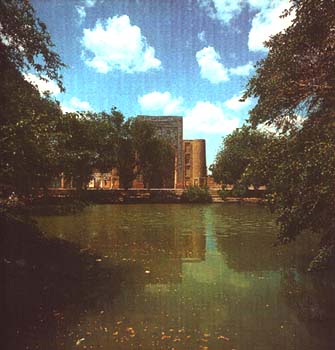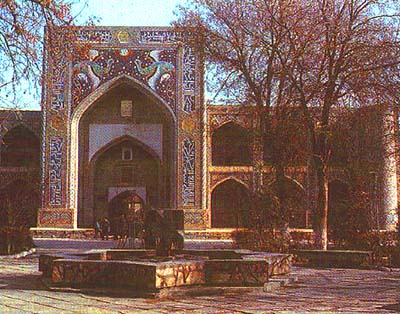 Beneath
the Taq-i-Sarrafan and parallel to the street runs a narrow canal born
of malicious and high-handed intent. Around 1620 the khan's grand vizier,
Nadir Divanbegi, wanted to put a reservoir in the city center on the site
of the house of a lonely old woman. She ' refused to move so he had a canal
built under her house, dissolving its mud foundations and walls. The woman
fled and Divanbegi built his reservoir. Beneath
the Taq-i-Sarrafan and parallel to the street runs a narrow canal born
of malicious and high-handed intent. Around 1620 the khan's grand vizier,
Nadir Divanbegi, wanted to put a reservoir in the city center on the site
of the house of a lonely old woman. She ' refused to move so he had a canal
built under her house, dissolving its mud foundations and walls. The woman
fled and Divanbegi built his reservoir.
It is the beautiful pool of Lyab-i-Khauz, beyond
Taq-i-Sarrafan, where the soul of pre-Soviet Central Asia survives with
greater charm than anywhere else. If you do nothing else in Bukhara,
come here for tea. The pool's sides were stepped, as usual for a khauz,
to let people get at the water whatever its level. Nowadays the water is
for gazing at, not washing in. Around it, under century-old plane trees,
shashlyk , plov and chaise served all day to a core clientele of turbaned
neo-dervishes - and to others who are patient.
 Not content with his pool, the grand vizier flanked it with
two grand buildings in his own memory: the Nadir Divanbegi madrasa and
khanaga, both completed around 1620. The madrasa was originally intended
to be a caravanserai but the khan inaugurated it, probably by mistake,
as a madrasa. Nothing the khan said could be unsaid so it was hastily converted.
It has a barber's shop and cafe in its south wing, a bureau de change to
the left of the pishtak on the inside, and a very striking mosaic above
the entrance arch. The sun, with a Mongol face like those behind the lions
of Samarkand's Sher Dor madrasa, illuminates two dazzling if strangely
hybrid birds, each sheltering a grazing goat. All that remained of the
mosaic in 1970 was a faint imprint from which it has been completely restored.
Not content with his pool, the grand vizier flanked it with
two grand buildings in his own memory: the Nadir Divanbegi madrasa and
khanaga, both completed around 1620. The madrasa was originally intended
to be a caravanserai but the khan inaugurated it, probably by mistake,
as a madrasa. Nothing the khan said could be unsaid so it was hastily converted.
It has a barber's shop and cafe in its south wing, a bureau de change to
the left of the pishtak on the inside, and a very striking mosaic above
the entrance arch. The sun, with a Mongol face like those behind the lions
of Samarkand's Sher Dor madrasa, illuminates two dazzling if strangely
hybrid birds, each sheltering a grazing goat. All that remained of the
mosaic in 1970 was a faint imprint from which it has been completely restored.
 The
khanaga on the opposite (west) side of the pool was once a hostel for wandering
dervishes but in Soviet times became an exhibition hall. Now almost everything
on show is for sale. Between the pool and the madrasa, in the middle of
a small formal garden, there is a modern statue commemorating the 1000th
birthday of an ancient 'wise fool'. Khodja Nasreddin was a Robin Hood character
who starred in countless Sufi children's stories and was loved by Soviet
mythologists for his instinct for the redistribution of wealth by direct
action. The
khanaga on the opposite (west) side of the pool was once a hostel for wandering
dervishes but in Soviet times became an exhibition hall. Now almost everything
on show is for sale. Between the pool and the madrasa, in the middle of
a small formal garden, there is a modern statue commemorating the 1000th
birthday of an ancient 'wise fool'. Khodja Nasreddin was a Robin Hood character
who starred in countless Sufi children's stories and was loved by Soviet
mythologists for his instinct for the redistribution of wealth by direct
action.
The north side of the complex is formed by the Kukeldash
madrasa (1568-9), Bukhara's biggest and most austere, with 160 cells and
a courtyard 80 by 60 m. The builder was Kulbaba Kukeldash, whose name means
'foster-brother of the Khan' (Abdullah). The decorative art of the era
formed a sober interlude between the restrained opulence of Ulug Bek and
the flamboyance of the 17th century. This madrasa is said to be notable
for its main cupola, supported by four intersecting arches, and the alabaster
pointing on the ceilings of its octagonal corner halls. But it's at least
temporarily closed to visitors, despite being marked on one map as a hotel.
[back]
|

